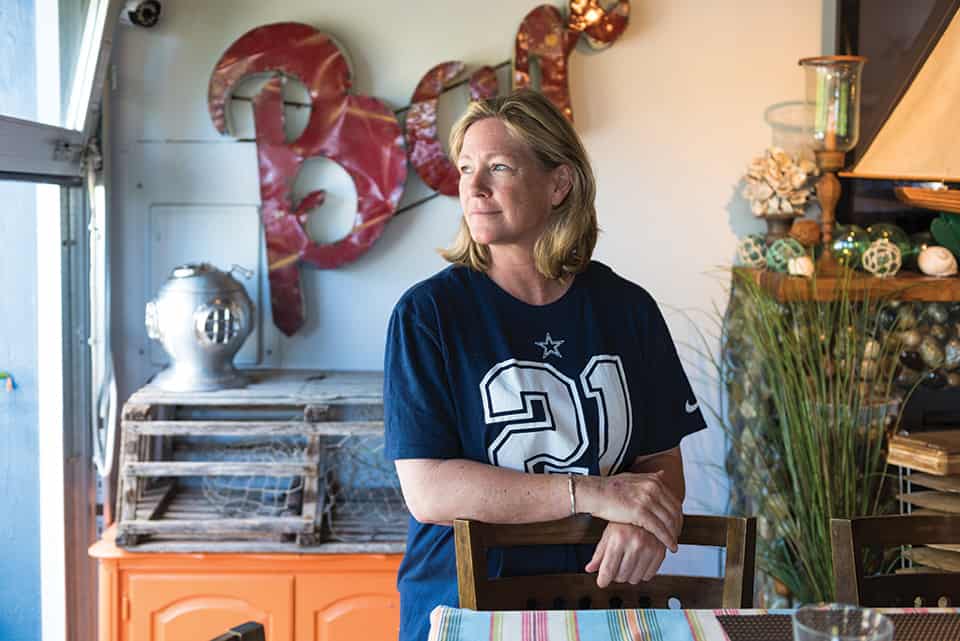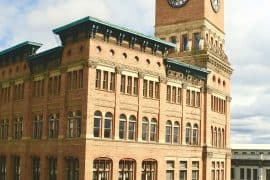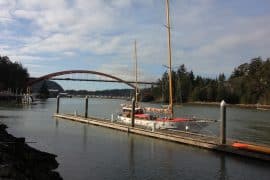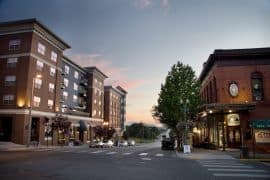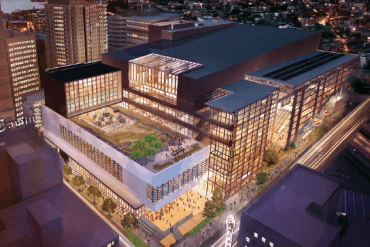written by James Sinks | photos by Michael Schoenholtz
From Minnesota to the Puget Sound, the United States-Canadian border traces the 49th parallel, stretching some 2,500 miles. The boundary doesn’t stop when it hits the water. It extends over the waves to the Georgia Straight. In doing so, an oversight in the 1849 Oregon Treaty, the line clips the end of Canada’s Tsawwassen Peninsula, creating a 5-square-mile lobe of U.S. soil, an island offshore.
This is Point Roberts, Washington. The place at the end of the line.
Formally an exclave, the Point—as locals call it—is more than a geopolitical oddity where a twenty-four-hour border crossing makes it virtually a gated community. It’s also a miniature slice of small-town America, with the easygoing rhythm of a place where nobody’s in a hurry to get much of anywhere.
Of course, it helps that there’s not a long way to anything in Point Roberts, which is crisscrossed by tree-shaded roads on which you’re just as likely to see horses and rabbits as cars.
Eagles bank overhead. With water on three sides, windswept beaches complete almost every vista.
To drive here, bring your passport and your best manners—you’ll need to clear two border crossings with security officers who do not like funny jokes, then drive 25 miles through Canada. (Two days a week, you can catch a puddle jumper flight to the grass airstrip from Bellingham.)
The northern neighbor of Point Roberts is the Canadian municipality of Delta, a bedroom community for Vancouver, B.C., with a ferry terminal, strip malls, Starbucks and rows of suburban houses.
Across the border there’s no such bustle. A recent headline from the Point Roberts monthly newspaper: “It’s time to fancy up those rusty mailboxes.”
Point Roberts is home to 1,300 people and 2,050 housing units, mostly on larger lots. Most of those are vacation homes on septic systems, which cuts down the ability to develop.
For visitors—the population triples come summer—the place has rental houses and marina slips, a liquor store with 6-foot-high stacks of Bud Light, a handful of eateries, yoga, a campground, a bed and breakfast, and “Boundary marker one,” the circa-1861 marble obelisk designating the westernmost land point on the 49th parallel.
At the marker, you also get a sense of the nonexistent local hysteria about border control—no wall here, just a foot-tall yellow curb that might stop a bouncing basketball.
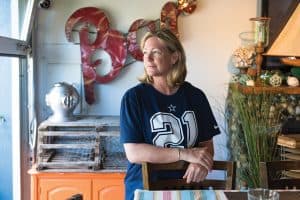
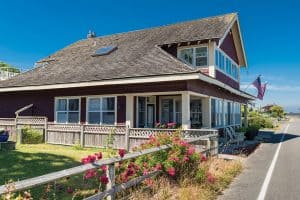
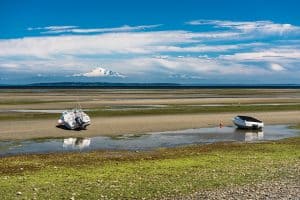
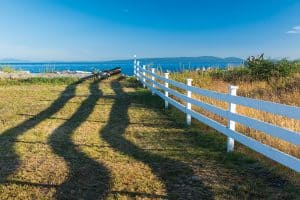
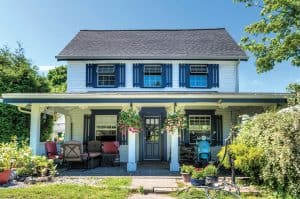
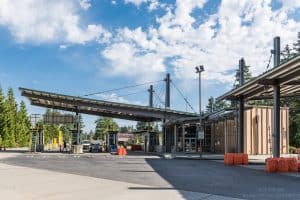
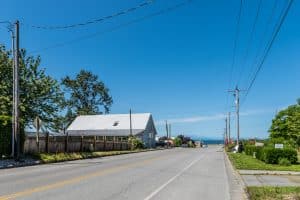
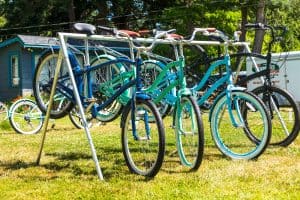
Before the arrival in 1792 of explorer George Vancouver, who named the point after his friend, Captain Henry Roberts, the area was a salmon fishing hub known as Chelhtenem by the region’s Salish tribes. The name translates as “racks for drying seafood.”
At Lily Point, at the base of sandy cliffs on the southeast corner of the peninsula, the catch would sometimes number 10,000 fish a day, according to the historical society. The forested bluff and beach is now a park with hiking trails and nesting bald eagles and herons.
Today, canneries and the mill are gone, and the economy rides on tourism and cross-border bargain hunting for fuel, booze, groceries when the Canadian dollar is strong, and parcel shipping.
There are four gas stations clustered off Tyee Drive, with prices 30 percent lower than in Delta with fuel sold by the liter, and shipping businesses to help customers avoid surcharges for international delivery.
At the market, rows of rental mailboxes sit alongside the refrigerated cheese.
It’s the closest place to Vancouver that you can get a medium rare burger, thanks to more strict Canadian culinary standards. And depending on the time of year, Point Roberts also has the warmest beach in the state.
When the tide pulls back at Maple Beach, it exposes sandy tidal flats that bake in the sun—when there is sun. The shallow pools and returning tide can approach 80 degrees. During minus tides, you can walk to a border marker a half-mile offshore in Boundary Bay.
There’s so little crime—a border crossing does tend to cut down on unwanted visitors—that the recent theft of five lavender plants from the U.S. Post Office caused a stir.
The relative isolation and security checkpoint has bred a local brand of folklore: that the Point is teeming with people in the federal witness protection program.
Bennett Blaustein chortles at the suggestion. “A ridiculous rumor,” he said, rolling his eyes. He’s a volunteer for the local park board, and a recent California transplant who launched a local community access TV channel, something he studied in college before life got in the way.
The Point feels a bit like Cape Cod-meets-Midwest, with weathered cedar-sided houses framed against the ocean, next to the occasional singlewide and RV.
While there’s appetite for some economic development, there is no interest in becoming the suburb next door.
“It’s heaven,” said Darlene Perritt, smiling from behind the register at the Shell station that doubles as the local coffee roaster and FedEx shipping office. This is one of her four service jobs in the Point, something she said is not atypical.
There’s no high school. Students attend the local schoolhouse until third grade and then are bussed 45 minutes to the public schools in Blaine. There’s a sneeze-and-you’ll-miss-it downtown with community center, art gallery, bike rental/bong shop (but nothing to smoke), and the Saltwater Café.
Saltwater Café owner Tamra Hansen came to the Point with a former boyfriend to escape the bustle of the Eastern seaboard, where they opened and marketed luxury restaurants. The boyfriend in the rearview mirror, she founded her charming eatery and coffee shop a year ago.
Tranquility keeps people in the Point, she said, but she also likes to joke about how it attracts those who want to escape. “We’re out here,” she grinned, “because we’re not all there.”
Past the 8-foot Statue of Liberty on Gulf Road at the marina, general manager Jacquelyne Everett is trying to lure additional boats—the marina can accommodate 917 and is two-thirds full—and hopefully bigger ones. She’s a Canadian transplant who married an American and settled here, making her a “duallie,” or dual citizen.
The port is also home to the Compass Rose restaurant, where you’ll find a full bar, seafood, and Darlene Perritt in the evenings. Oh yes, and burgers.
Everett said the marina’s new owners—investors from China—see potential in bigger yachts, which will usher in more jobs. Chinese investors also recently bought the golf course with plans to fix it up.
“There is money coming in and people appreciate that,” she said. “But there is also some discomfort.”
Thirty years ago, Nick Kiniski was an up-and-coming professional wrestler on the WWF tour, following in his father’s career path. But after a falling out on the tour, Kiniski stowed his singlet and bought a tavern at the end of America. It’s known as Kiniski’s Reef.
He also trained to be a paramedic. Now, when not at his bar, which offers front-row seating for dazzling sunsets on the Salish Sea, he works as a fire battalion chief on Orcas Island.
He reminisces about the heyday when he’d sell piles of gambling pull-tabs and the parking lot would fill on weekends, especially when there was no drinking in Vancouver on Sundays. It’s quieter now. “Like wrestling, you take your hits but you can’t quit,” he said.
Families trade binoculars in hopes of spotting a local pod of orcas at Lighthouse Marine Park, where there’s a weathered deck, weathered wind shelters and generally a fair amount of weather.
Despite the park’s name, there’s no lighthouse—only a signal light. A local nonprofit hopes to build one.
Sandwiched between two mammoth rusty anchors is a carved slab of black granite that is part of a cross-continental art sculpture. Called “Sunsweep,” it curves eastward and marks the endpoint of an imaginary arch that traces the path of the sun along the border. An identical piece of granite faces west where the border ends at the Atlantic.
While Point Roberts has bucolic scenery, it is a bad place to get sick. There’s a clinic open three days a week, but the closest available hospital and pharmacy are in Bellingham. And there’s a stark trade-off for Canadians and duallies—live here and you lose access to Canada’s universal health coverage.
Blaustein, the TV station producer, said when people move here, a must-have is insurance that covers LifeFlight helicopter transport. The health care situation means people don’t stay forever, he said. He figures he’ll be here maybe twenty years.
Kitty Doyle is reaching the end of her tenure. She moved here twenty-seven years ago with her husband, a Navy veteran, and eventually opened an art gallery in the garage. The Blue Heron Gallery has grown to a hodgepodge of 130 local artists from carvers to jewelers to people that make stuff with plates.
Her husband died two years ago. This winter, she’ll shutter the business and move back to Florida to be closer to her children, doctors and public transit.
Doyle paints watercolors of the idyllic local landscape at the end of the line.
“It’s a fabulous, beautiful community, and there is nothing else like it, but it’s time,” she said, sitting on her patio alongside pots of lettuce and vibrant lavender. She smiled—no, she didn’t take the lavender from the post office.
Also check out our latest story about rescue workers: Aid at Elevation


